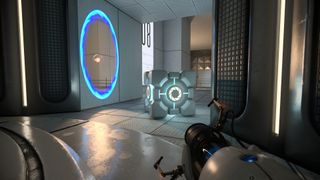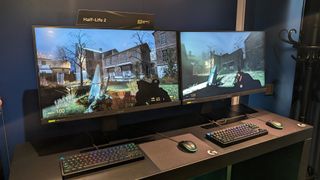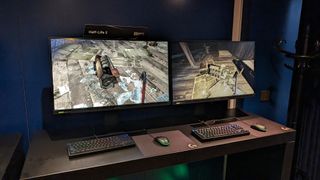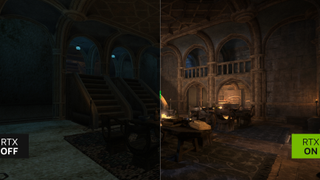[ad_1]
In a darkened room at Nvidia’s ‘Future of Gaming’ showcase at a fancy London hotel earlier this week, I was ushered before a bank of computer screens showing live gameplay from a very exciting game: Valve’s Half-Life 2.
Alright, HL2 isn’t a new game – in fact, it turns 20 this year! – but it’s still a timeless classic that has topped many a list of the best PC games. And while Valve will probably never release Half-Life 3, the mega-hit second game still has plenty of life left in it, thanks to Nvidia’s incredibly clever RTX Remix tool.
Announced way back in September 2022 at Nvidia’s GTC showcase, RTX Remix is an AI-powered tool for remastering old 3D games with updated graphics and fancy modern features like ray tracing. Remix entered open beta earlier this year, and is primarily targeted at modders looking to visually upgrade their favorite games; it’s built on Nvidia’s AI-focused ‘Omniverse’ platform, offering a comprehensive box of tricks for making the remaster process faster and easier than ever before.

Nvidia worked with official developers to create a showcase for Remix in Portal with RTX, a shiny new remaster of the legendary 2007 puzzle game, but Half-Life 2 RTX is a passion project being produced by modders with Nvidia providing some background support. And can I be honest? It looks f*cking awesome.
Giving new life to Half-Life
The live demo I was shown by Nvidia showcased one of the game’s most iconic locations: the run-down, zombie-infested town of Ravenholm, where protagonist Gordon Freeman ends up after a less-than-fortuitous series of events. Two displays were set up side-by-side to show both the original game and the Remixed work in progress – and the difference was phenomenal. For all its accolades, classic Half-Life 2 does very much look like a game made two decades ago, while the work-in-progress remaster looks great.
RTX Remix allows for modding in real-time – in other words, you can have the game running while also having the dev environment open in a different tab, and changes you make are reflected (after a short delay) in the live game. An Nvidia staffer gave me a brief walkthrough on using the tool, and it’s a remarkably streamlined process. You can generate an asset library by simply walking around in-game and letting Remix capture your surroundings, and use generative AI tools to rapidly produce improved textures and 3D models.

One scene displayed during the demo saw me walking through a dimly lit courtyard beset with corpses – including a dismembered pair of legs hanging from a tree. Despite the grisly setting, I couldn’t help but be impressed: the legs swing from a rope and cast realistic dynamic shadows in the Remixed version, while the original features no shadows at all. It also highlighted the improved ground textures, and Nvidia pointed out in a different scene that Remix’s generative AI capabilities can extrapolate the environment to add extra details – in this case, climbing vines and weeds partially covering a ruined wall.
CONTENT WARNING: You can see the clip below, but please be aware that it contains some 2004 gore as described above, now with added ray tracing! I do wish Nvidia had given me a slightly less gruesome example.
Another standout example (albeit a rather mundane and less gory one) was a simple 3D object asset of a broken engine. I lined up both versions of the game to view the item’s original and Remixed models, and the new model is massively more detailed. And I do mean massively: not only does the ray tracing work wonders to more realistically illuminate the object, but it actually looks like a 3D asset from a 2024 game, not a 2004 one.

A change of heart – and art
I’ll admit, when RTX Remix was first announced, I was pretty cold about it. I liked the look of the (still in development) Elder Scrolls III: Morrowind remaster, but I had fears that Remix would become a blunt implement for major publishers to churn out low-effort remasters that threw the important art direction of classic games in the trash. I wasn’t the only one, either – my colleague Allisa James had some major reservations about Remix too.
But I’m relieved that two years on, Nvidia is putting power in the hands of modders rather than shareholders. When I asked Nvidia GeForce ‘Evangelist’ Jacob Freeman (amusingly appropriate name, I know) about RTX Remix, he explained that the tool would be available for official game dev projects, but had been created with modders – not profits – in mind. It’s certainly a refreshing change of pace, and it helps that some of these Remix projects look pretty fantastic.

I still maintain that some games might suffer from AI-infused remastering. Mirror’s Edge is a good example. For starters, it still looks pretty good today, but more importantly, it’s a game where color and lighting are used very carefully to inform the gameplay – meaning that a Remixed version might impact the delicate intersection between art direction and game mechanics. But for games like Morrowind and Half-Life 2, which have decidedly not aged well from a graphical standpoint, it’s perfect. I can’t wait to see what talented modders create with it.
If you’re interested in RTX Remix, you can download the beta version from Nvidia’s website. Bear in mind that right now, Remix only works with DirectX 9 and some DirectX 8 games – so in other words, you’re currently limited to a pool of games released between 2000 and 2006. Of course, the tool is still in development, and Nvidia has said that it would like Remix to work with a much broader spectrum of PC games, so in other words: watch this space!
(I still think ‘Omniverse’ is a dumb name, though.)
You might also like…
[ad_2]
Source Article Link

